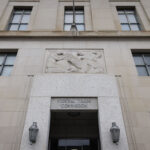Two weeks ago, Puerto Rico was spared a devastating hit when Hurricane Irma ripped up the Caribbean. This time, it may not be so lucky.
The bankrupt island, already contending with the aftermath of a storm that left as much as $1 billion of damage and hundreds of thousands still without power, faces even more upheaval with Hurricane Maria set to hit as soon as Tuesday night. The government ordered rationing of basic necessities, including water and batteries, although those items were already gone from some San Juan store shelves as residents prepared for what could be the worst storm for the U.S. territory in decades.
“If you are in a flood zone or in a wood house, your life is in danger,” Governor Ricardo Rossello said during a press conference Monday in San Juan. “There has never been an event like this in our history in the last 100 years. Our call is for all citizens to move to a safe place.”
Puerto Rico is facing an active hurricane season with little financial ability to navigate a natural catastrophe. It filed for bankruptcy in May after years of economic decline and borrowing to fill budget gaps. A series of defaults have effectively left it unable to raise money in the capital markets. And its aging government-owned electric utility, the Electric Power Authority, is also operating under court protection from creditors. Puerto Rico’s emergency fund stood at about $32 million before Irma passed through.
Prepa, the government-run utility, is still trying to restore power to hundreds of thousands of residents after its electrical infrastructure sustained as much as $400 million of the nearly $1 billion of damage from Irma. It was already in need of upgrades because it relies on oil to produce most of its electricity and the median plant age is 44 years, more than twice the industry average.
“We will not have sustainable electric infrastructure in the near future,” Rossello said. “We will be bringing in crews from outside of Puerto Rico to attend to these measures.”
Hurricane Maria became a Category 5 storm late Monday with maximum winds of 160 miles per hour, according to the National Hurricane Center.
Rossello’s administration has opened nearly 500 shelters throughout the island and may set up more. Water, batteries, baby food and generators were already scarce in San Juan by Monday evening and motorists waited at least half an hour in line to buy gasoline. Officials estimate the last time the island withstood such a powerful storm was in 1928 with Hurricane San Felipe.
Maria’s threat hasn’t rattled the bond market, given that Puerto Rico has already defaulted and is seeking to have some of its debts discharged in bankruptcy. While its securities were actively traded as the storm gathered force, Puerto Rico debt maturing in 2035 changed hands Monday at an average price of 58.8 cents on the dollar, in line with where they’ve traded over the past couple of weeks and up from 57.9 cents on the dollar at the end of August.
–With assistance from Jonathan Levin.
Was this article valuable?
Here are more articles you may enjoy.


 SIAA Announces Strategic Partnership With Progressive
SIAA Announces Strategic Partnership With Progressive  Florida Heads for Smallest Orange Crop in Nearly a Century
Florida Heads for Smallest Orange Crop in Nearly a Century  Experian: AI Agents Could Overtake Human Error as Major Cause of Data Breaches
Experian: AI Agents Could Overtake Human Error as Major Cause of Data Breaches  Trump Nominates WeatherTech’s MacNeil to Be FTC Commissioner
Trump Nominates WeatherTech’s MacNeil to Be FTC Commissioner 

